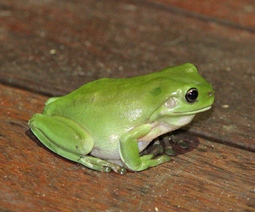Common green tree frog

Common name: common green treefrog
Scientifc name: Litoria caerulea
Family: Hylidae
Conservation status: The common green treefrog is listed as Least Concern in Queensland (Nature Conservation Act 1992).
Description
The common green treefrog is a large, robust frog with moderately sized legs. Males grow up to 90mm, and females to 113mm. It is usually bright green with golden eyes, sometimes with white spots on sides and back. Like all tree frogs, they have large flat discs on fingers and toes to help with climbing.
Habitat and distribution
The common green treefrog occurs in all habitats from desert to coastal swamps, including dry vine thickets, but not dense tropical rainforest. In the dry season they shelter under bark, in tree hollows, in and under logs, and under rocks. This species is sometimes found in toilets, bathrooms, drain pipes and suburban gardens. It is commonly attracted to lights. The species occurs throughout mainland Australia and New Guinea.
Life history and behaviour
For common green treefrogs, daytime is for hiding out in tree hollows, crevices and plants. These frogs come out at night to feed on insects, but they will eat almost anything, including bats and small snakes.
Breeding takes place in permanent pools, summer filled water holes and swamps. It may occur from September to March, depending on heavy rain, generally peaking between December and February during the wet season. At night time during the breeding season, males call to attract females, using an inflatable bag under the jaw to project the call. Listen for a low, monotonous 'crawk-crawk-crawk', especially when it's raining or about to rain.
Listen
Listen to an audio clip of the common green tree frog (MP3, 90KB)†.
† Requires an appropriate media player.


